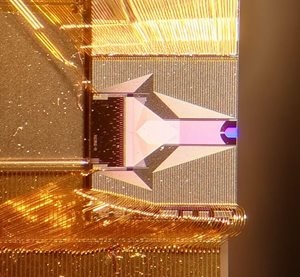Feb 5 2019
Scientists have demonstrated for the first time the possibility of performing ghost imaging, a non-traditional imaging technique, by using a less-expensive, chip-based light-illuminating device.
 Researchers showed that ghost imaging could be performed using this optical phased array chip, which measures only 4 x 4 mm. (Image credit: Takuo Tanemura, University of Tokyo)
Researchers showed that ghost imaging could be performed using this optical phased array chip, which measures only 4 x 4 mm. (Image credit: Takuo Tanemura, University of Tokyo)
This significant step toward chip-based ghost imaging could render the imaging technique useful for applications like light detection and ranging (LIDAR), chip-scale biomedical imaging, and Internet-of-things sensing devices.
Ghost imaging has attracted considerable attention since it can be carried out using a less-expensive, single-pixel detector rather than a complex, and typically high-cost, camera. Upon being used in combination with the compressed sensing computational strategy, ghost imaging can also realize faster imaging and higher sensitivity compared to conventional methods, specifically in non-visible wavelength ranges.
In the Optics Express journal from The Optical Society (OSA), scientists from the University of Tokyo have detailed the ways in which a bulky optical component usually used for ghost imaging was replaced with a newly developed chip-based optical phased array (OPA) measuring just 4 x 4 mm.
“If low-cost, single-chip imaging devices were commercialized it would enable low-cost LIDAR, which is the technology self-driving cars, drones and autonomous robots use to see their environment,” stated Takuo Tanemura, who headed the research team. “Also, small imaging devices could be embedded into smartphones to allow improved 3D imaging and healthcare monitoring.”
Faster, Lower Cost Imaging
In ghost imaging, an object is illuminated with random speckle patterns that vary over time. The object’s image can be obtained by correlating the transmitted, or reflected, optical power traveling through the object with the intensity distribution of the speckle patterns.
Despite being put forward more than a decade ago, this imaging strategy has mostly been restricted to the lab due to the slow and bulky spatial light modulators used to produce the speckle illumination patterns.
In the new study, the scientists solved an intrinsic difficulty in applying large-scale OPAs, in which an array of adjustable integrated waveguide elements is used to control the phase of light. Rather than attempting to precisely align all the optical phases, which is difficult to achieve in practice, they developed an OPA where the phase-controlling elements function in a random manner. This enabled them to produce randomly changing speckle patterns that were ideal for ghost imaging.
Compared with previous implementations of ghost imaging using spatial lightwave modulators that were large and slow (typically operating in the kilohertz range), using an integrated phased array is much more compact and offers lower cost. Our approach also has the potential to reach greater than gigahertz operational speeds, or six orders of magnitude faster than SLM-based approaches.
Takuo Tanemura, Associate Professor, University of Tokyo
The researchers created the random speckle pattern by applying rapidly varying random electrical signals to 128 integrated phase shifter elements on the OPA. They exhibited 2D imaging with over 90 resolvable points in the X direction (ascertained by the number of phase shifters) and 14 pixels in the Y direction (ascertained by the number of wavelengths tested). The results were in good agreement with theoretical predictions.
Smaller, Cheaper LIDAR
This type of imaging device could be particularly useful for LIDAR, which currently produces 3D images using a bulky mechanical mirror to steer a laser beam. It is estimated that the cost, size and response time of LIDAR needs to be reduced by 1 to 2 orders of magnitude to be widely deployed in non-luxury mass-market cars. A chip-scale ghost imaging device could accomplish this.
Takuo Tanemura, Associate Professor, University of Tokyo
The scientists will continue their efforts in making the new technology much more practical. They are performing experiments with electro-optic phase shifters that could improve the operation of the OPA to speeds beyond gigahertz. They also intend to improve the scan rate further and would want to incorporate all the optical components on a single chip as the OPA to achieve 2D and 3D imaging without the need for off-chip components.
“If we’re able to integrate all the necessary components, including the light source and detector, on a chip, then a single-chip ghost imaging device would be possible,” stated Tanemura.